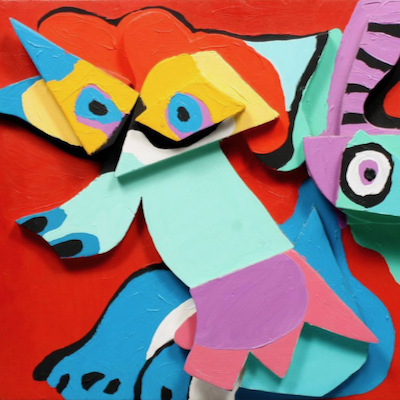
Details
Artist
Styles
Painted Stone Relief -Hand signed and numbered by Appel // Karel Appel’s Floating Family (1976) is a vibrant painted stone relief that exemplifies his bold and expressive style. This circular work, hand-signed and numbered, features abstract, overlapping faces and forms that seem to emerge organically from the black background. Rendered in bright reds, blues, yellows, and greens, the figures appear interconnected, evoking a sense of unity within the chaos. The rough textures and layered shapes bring depth to the composition, creating a tactile quality that enhances its sculptural presence. Floating Family captures Appel's fascination with primal expression and the interconnectedness of human forms, transforming stone into an energetic and emotive celebration of family and togetherness.
Floating Family, 1976
form
Medium
Size
62.2 x 62.2 cm
- Inches
- Centimeters
Edition
Price
- USD
- EUR
- GBP
Details
Artist
Styles
Painted Stone Relief -Hand signed and numbered by Appel // Karel Appel’s Floating Family (1976) is a vibrant painted stone relief that exemplifies his bold and expressive style. This circular work, hand-signed and numbered, features abstract, overlapping faces and forms that seem to emerge organically from the black background. Rendered in bright reds, blues, yellows, and greens, the figures appear interconnected, evoking a sense of unity within the chaos. The rough textures and layered shapes bring depth to the composition, creating a tactile quality that enhances its sculptural presence. Floating Family captures Appel's fascination with primal expression and the interconnectedness of human forms, transforming stone into an energetic and emotive celebration of family and togetherness.
- Recently Added
- Price (low-high )
- Price (high-low )
- Year (low-high )
- Year (high-low )
Karel Appel
The Clown With The Golden Tears, 1978
Limited Edition Print
Etching And Aquatint
USD 2,000
Karel Appel
Plus Malin Et Plus Debile Que Nous, 1978
Limited Edition Print
Woodcut
Currently Not Available
What is the CoBrA movement?
CoBrA stands for Copenhagen, Brussels, and Amsterdam; the group was formed with a desire to break away from the existing art movements of the time. Their critique of Western society led them to experiment and evolve into a significant international movement. CoBrA was founded on November 8, 1948, at the Notre Dame Café in Paris, where its manifesto was signed by Karel Appel, Joseph Noiret, Corneille, Christian Dotremont, Constant, and Asger Jorn. The group was united by a shared commitment to freedom in both form and color, and their work emphasized experimentation and spontaneity.


































































